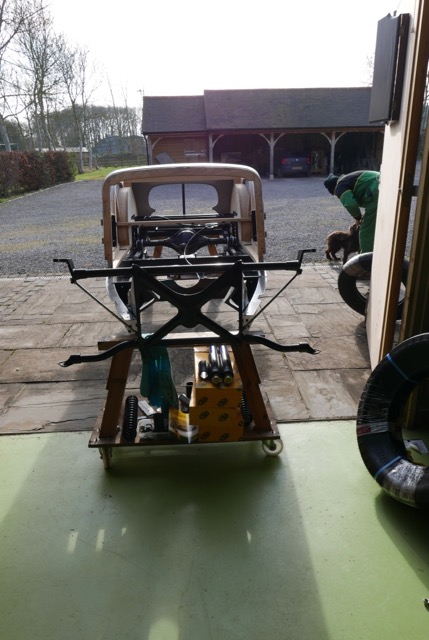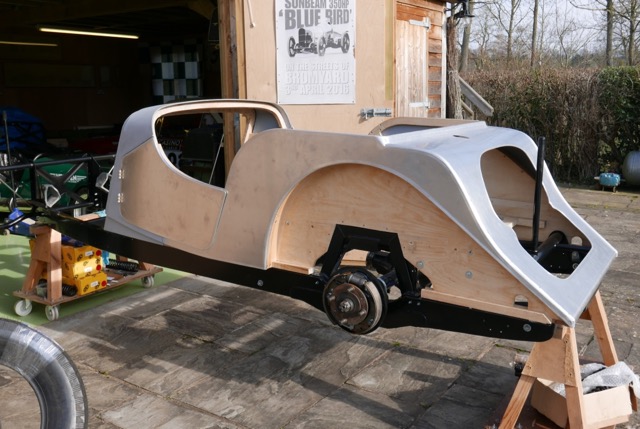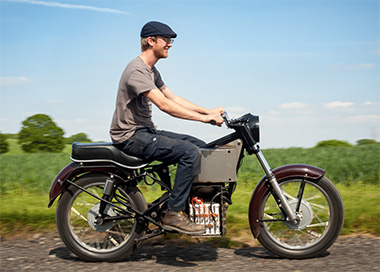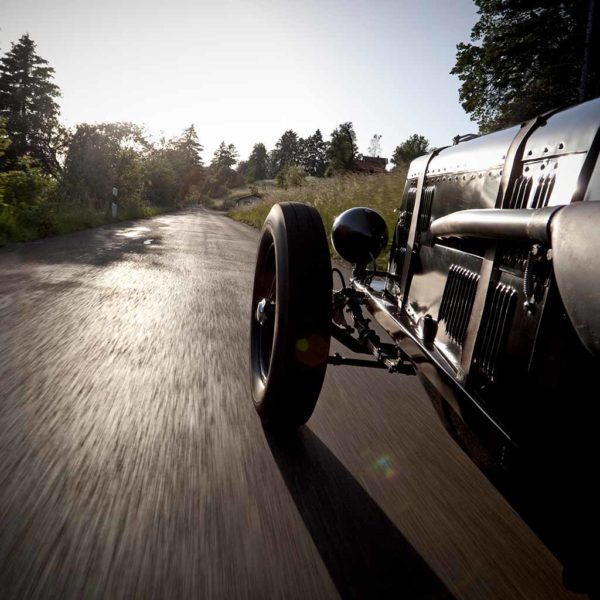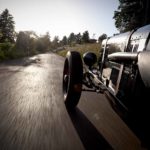Sol – so named because of its resting place for the past 40 or so years – The Solway Firth – and the incredible coincidence that the previous owner ‘s Grandfather had once owned The Solway Lass, a 2 masted Schooner on which Jeremy had once sailed around the Whitsunday Islands!!
Those of you who read MOG magazine will have already seen several instalments entitled ‘The Road to Africa’ which cover the beginnings of our story, but for those who have not, here goes….
The tale begins in March of 2017 as the plans to create ‘Holden Morgan’ the Midlands Morgan Agent, were coming to fruition, Jeremy Holden was casting his eyes around for a project, ideally as a competition car with historic circuit racing in mind, most importantly however, it had to be a Morgan. A marque with which he was more than familiar having owned several over the years, mostly competition cars for hillclimbs and circuit races, although one Moss Box +8 was used as an Historic Rally Car.
The link between Holden Vintage & Classic and Rally Round provided the inspiration in the form of details regarding an event for historic cars, starting in Dar es Salaam and finishing in Cape Town 28 days later – the perfect event – only a car meeting the required criteria was needed. It had to be something relatively simple yet rugged and reliable mechanically, ideally it needed to carry 2 spare wheels, have space for spares etc, and a decent fuel capacity, plus it HAD to be a Morgan!
Amazingly, and as with a previous Holden Project, Ebay provided the solution, although unlike the previous project (Julian’s 2CV) this one stood absolutely no chance of passing an MOT the day after collecting it. The car then, was a 1955 Morgan +4, sad and down-at-heel looking, but most importantly, complete. This ticked nearly all of the boxes – strong and reliable Triumph TR engine, straight forward Moss gearbox and leaf sprung live axle, durable steel chassis and flexible yet strong ash body frame, carried the all important twin spare wheels vertically at the back, a decent size tank, but room to make a larger one if needed.
After a few nervous days, Jeremy ended up the winning bidder, and sallied forth to Scotland with the trailer to collect his prize. It turned out in conversation with the seller that there was, as mentioned at the head of the page, a connection in the form of a sailing boat on the opposite side of the world, and hence the car being named SOL.
During the course of the journey south, many years of storeage in the damp Solway environment proved too much for the frail side rails and the chassis gave way, the middle of the car settling down on the trailer leaving more than the required 4 contact patches with the ground. On arrival at Holden Vintage & Classic, and following a quick assessment, a plan was hatched to put the car on display in the shop, which was eventually accomplished with the addition of a set of castor wheels to act as a trolley for the chassis and a trolley jack to lift it.
During its resting period in the shop the car dried out significantly, depositing several piles of flakey rust and timber residue on the floor. It was noted during this time, that although not in the best of states, the car was very complete and surprisingly original, having a correct TR2 engine, all of its original instruments, a complete set of 16 inch steel wheels and was among the earliest cars to carry the traditional Morgan shape that has become so recognisable.
Fast forward now to July and the car has been moved out of the Shop to make way for new cars, its resting place the Holden Morgan Workshop, where work began in earnest to dismantle and carefully assess exactly what we had and formulate a plan for the ensuing rebuild.
The engine and gearbox were removed, together with the body frame and bulkhead, all this being accomplished in a manner that has been seen by very few cars! The engine was taken to one side and carefully disassembled, photographed and videoed using among other gadgets a time-lapse camera. The footage being assembled for display purposes at the Run for the Hills event. With the major mechanicals and the body removed, it was possible to see the extent of the corrosion and the work required to reconstruct the chassis. As it was by now August and the weekend of the Run for the Hills event was fast approaching, an event where Holden Morgan, along with all the other UK Morgan Dealers, would have a display stand. Sol would take pride of place, with a TV screen mounted on the front crosshead showing the video of the dismantling process, and to act as a centrepiece of the Holden stand, as well as to unveil the project to Morgan owners and enthusiasts.
In order to provide enough support to the chassis for the weekend, our ever helpful neighbours at Active Fabrication manufactured a pair of part side rails and a cross member to prop it all up, as well as producing a couple of brackets to hold the TV screen. Helpfully, these mounted on the cross head and meant no extra holes were drilled!!
Following on from the Run for the Hills event, the chassis was stripped completely and sent to GEE Ltd in Nailsworth. GEE specialise in the restoration and supply of structural steelwork components for Morgans and were not at all fazed by the chassis. In fact, they were more than happy to help, and came up with a few useful suggestions on how to strengthen the chassis at critical points and how best to increase the ground clearance. A necessity for a car heading ‘off the beaten track’!!
While GEE were performing miracles with the chassis, Steve Barnes at VSM was called upon for advice regarding the body frame and sheet metal work. Sadly, all of this was deemed to be beyond economic salvation and a new ash frame commissioned, once completed, this was expertly panelled by Steve at VSM, who at the same time made a new bulkhead and pair of front valances.
All of this work was completed by the aforementioned outside specialists leaving little to do in the Workshop, although the engine that had been the focus of the disassembly video for Run for the Hills had been sent away to Mike Jones Engines in Leominster for any necessary machine work to be undertaken. At this point, a second ‘Project’ Car enters our story, as Holdens purchased, at Auction, another +4, this time a 1953 ‘Interim’ car – so called because the front end styling was a half way house between the Flat Rad +4 and the traditional shape of Sol. This car was fitted with a more desirable (for Sol) but non original TR3 engine which offered certain improvements over our TR2, not least of which was a high port cylinder head, giving a performance improvement. It was decided therefore to do a swap and use the TR3 engine for Sol and fit the more correct TR2 to the interim car. The TR2 was retrieved from Mike’s Workshop and the TR3 delivered. Progress with the rebuild is ongoing!
Towards the end of November there was a repaired, strengthened and slightly modified chassis on the Workshop floor, together with a body frame and a bulkhead and front valances. During the course of the chassis work, the Morgan suspension guru’s at SSL got involved, working out spring rates and damper types and settings to offer improved control over the suspension system of the finished car, which incorporated a special frame over the rear axle to allow fitment of twin adjustable shock absorbers to each side of the rear axle. This has become known as ‘The Coffee Table’ due to its shape and is designed such that it does not compromise the rear luggage board behind the seats. GEE and SSL between them had come up with suitable bracketry to mount all of this as well as the lower plates to attach the leaf springs to the rear axle, and as these parts arrived with the chassis, little time was lost in bolting plates and springs to the axle with longer and stronger than standard U-bolts. Before any work could commence, the bare chassis was set up on a pair of tressles to get the whole thing at an appropriate height to work on. Fortunately, GEE had pre aligned and drilled the front crosshead to the chassis , which saved a fair amount of time in getting the critical chassis alignment correct.
First thing was to assemble the leaf springs to the rear axle with the U-bolts and lower plates which then slotted neatly into the chassis and the body frame placed on top. Modification to the inner rear wheel arches was necessary to allow the body frame to fit around the Coffee Table. These were marked out and cut with a most useful battery circular saw. Having got the coffee table in place, the body was refitted and the bulkhead placed into the chassis with the body frame pushed against this to give a close fit. At this point the whole lot was clamped down using G-clamps to hold it all in place and holes drilled for bolts. Front valances, or inner wings, soon followed in a similar way being clamped into place and checked carefully before drilling holes.
The next step was to make up some floor boards. We measured the thickness of the remnants of the old floor boards that we had and set out to source similar material. Bromyard Timber stocked a size of exterior grade ply that was of the correct, or at least the metric equivalent of the size we required. Again our trusty battery saw was put to good use cutting out the boards after measuring and marking out on the bench.
To recap, we now have a body frame mounted to a chassis, with a bulkhead, inner wings, rear axle fitted and floor boards made.
What next then?
By now, the festive season was but a distant memory and attentions turned towards some of the other parts we may need. A list was drawn up of things such as front stub axles, brakes, rear brakes, handbrake mechanism, rear hubs, plus numerous other small parts required, all of which were ordered from the Morgan Factory Spares Department. Whilst the Factory were busy assembling this collection of parts, we had to sort out the fitting of an engine and gearbox. The only issue here being that both Sol’s engine and gearbox were away being rebuilt, the engine by Mike Jones in Leominster and the gearbox by Techniques Morgan in Hertfordshire. Fortunately, the whereabouts of a redundant TR block was known of and this, combined with the gearbox from Holden’s Interim car, kindly loaned for a while, provided the necessary combination to fit to the chassis to align engine mounts, pedals , sort out the propshaft length etc.
The major order of parts from the Factory was soon with us, and included all manner of components – front stub axles, brake discs, wheel bearings and seals, steering track rods, track rod ends, plus rear brake back plates and brake drums! When ordering the stub axles, an early decision was made to upgrade to 4/4 stub axles, as these offered greater strength than the original +4 type which had a tendancy to break under the stresses of competition work, something that was discovered in period, hence the reason for the original Supersports and later cars being fitted with stronger front stub axles. First job here was to ream the bushes in the stub axles to ensure the king pins were a correct fit, accomplished here in the Holden Workshop with a fixture fitted to the large pillar drill we have and a suitable machine reamer driven very slowly to provide the correct finished size. Next step was to fit the new wheel bearings and inner hub seal to the correct 4 stud hubs which had been sourced from GEE, then to assemble the front suspension onto the chassis. As the rear axle was already in place, it was a simple matter of placing the complete back plate assembly onto the axle end (far easier and quicker than trying to remove, refurbish and overhaul 50 odd year old components!), especially as the rear brakes have barely changed since Sol was built!
We now had a bodied chassis with front end sheet metal work in place, plus an engine and gearbox installed, onto which we could now put wheels. Sol was beginning to look more and more like a car!
A decision had been made to fit a scuttle roll hoop to provide greater structural integrity to the body and chassis at the point where the door hinges hang, so one was sourced via another Morgan Specialist. Sadly, this was not of the correct dimensions for a 1950’s era Morgan so we decided that, rather than try to modify something which was nicely made and finished we would be quicker and easier to make a new one, using the incorrect one as the basis of a pattern. Jeremy had a contact no more than a couple of miles from his home who had suitable tube bending equipment and was able to bend up a hoop to the required dimensions for us. At this point, Sol made her first journey on her own wheels, being moved to the neighbouring and aforementioned Active Fabrication who made the base plates and welded the scuttle bar together for us. Whilst in their workshop, Active Fabrication made a pair of storage boxes to fit in the space immediately in front of the rear axle and to each side of the propshaft, one for tools / spares and the other to carry the battery. They also produced an enlarged tool box to fit on the bulkhead top, one with a hinged lid that again can be used for spares and tools. Space for such items is going to be fairly limited, so it is necessary to maximise the use of every space we have.
Fabrication work completed and Sol made another journey, this time back to the Holden Workshop where the handbrake cables were fitted, together with the timber work that will support the fuel tank and the spare wheel carrier was also fitted at this time. Essentially now Sol is ready to have wings fitted and the bonnet made, but as there was to be a slight time delay, the decision was made to disassemble the car and send the main structural components away for powder coating. Thus the whole thing was reduced to a pile of components, ensuring that all the holes that needed drilling had been done and the chassis, front crosshead, ‘Coffee Table’ and spare wheel carrier were all sent out to County Powdercoating for a coat of satin black.
As I write this, we are awaiting the return of the finished powdercoating so that the build can commence in earnest…….





